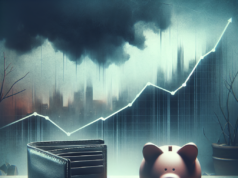
In recent months, financial distress reports have surged, revealing alarming trends that indicate a growing number of households and businesses are facing economic strain. As inflation rates rise and economic uncertainties loom, understanding the nuances of financial distress becomes imperative. This article delves into the definitions and indicators of financial distress, analyzes recent trends, explores contributing factors, assesses the impact of economic policies, presents real-world case studies, and offers strategies for mitigating financial distress.
Understanding Financial Distress: Definitions and Key Indicators of Economic Strain
Financial distress is a term used to describe a situation where individuals or organizations are unable to meet their financial obligations, leading to significant economic strain. Key indicators of financial distress include rising debt levels, increased late payments, declining credit scores, and a growing number of bankruptcies. For households, signs may manifest as difficulty in paying bills, reliance on credit for basic needs, and diminished savings. For businesses, indicators often include cash flow problems, reduced revenue, and an inability to secure financing. Understanding these indicators is crucial for identifying at-risk entities and implementing timely interventions.
The Current Landscape: Analyzing Recent Trends in Financial Distress Reports
Recent reports indicate a troubling increase in financial distress across various sectors. According to data from financial institutions and credit agencies, the number of households reporting difficulty in meeting financial obligations has risen by over 25% in the past year. Similarly, small businesses are experiencing unprecedented levels of financial strain, with many reporting a significant drop in revenue due to ongoing economic challenges. This trend is particularly pronounced in industries such as retail and hospitality, which continue to grapple with the aftereffects of the pandemic. As economic conditions fluctuate, the prevalence of financial distress is likely to escalate, necessitating immediate attention from policymakers and financial institutions.
Factors Contributing to the Surge in Financial Distress Among Households and Businesses
Several factors are driving the increase in financial distress reports. Chief among these is the persistent inflation that has outpaced wage growth, eroding purchasing power for many households. Additionally, rising interest rates have made borrowing more expensive, placing further strain on those with existing debts. For businesses, supply chain disruptions and labor shortages have compounded financial challenges, leading to increased operational costs and decreased profitability. Furthermore, the lingering effects of the COVID-19 pandemic continue to impact consumer behavior and spending patterns, creating an unpredictable economic environment that exacerbates financial distress.
The Impact of Economic Policies on Financial Stability and Distress Levels
Economic policies play a pivotal role in shaping financial stability and influencing distress levels among households and businesses. Recent fiscal measures, including stimulus packages and interest rate adjustments, have aimed to alleviate some of the financial burdens faced by individuals and organizations. However, the effectiveness of these policies is often debated. While some argue that such interventions provide necessary relief, others contend that they can lead to unintended consequences, such as increased inflation or dependency on government support. A balanced approach that fosters sustainable economic growth while addressing immediate financial distress is essential for long-term stability.
Case Studies: Real-World Examples of Financial Distress and Their Consequences
Several case studies illustrate the severe consequences of financial distress on individuals and businesses. For instance, a small restaurant chain that struggled to recover from pandemic-related closures faced mounting debts and ultimately filed for bankruptcy. This not only resulted in the loss of jobs for employees but also had a ripple effect on local suppliers and the community. Similarly, a family that relied heavily on credit to manage rising living costs found themselves in a cycle of debt, leading to foreclosure on their home. These examples underscore the far-reaching implications of financial distress, highlighting the need for proactive measures to support those affected.
Strategies for Mitigating Financial Distress: Insights for Individuals and Organizations
To combat the rising tide of financial distress, both individuals and organizations can adopt several strategies. For households, creating a comprehensive budget, prioritizing debt repayment, and seeking financial counseling can provide a roadmap to recovery. Additionally, building an emergency fund can help buffer against unexpected expenses. For businesses, diversifying revenue streams, maintaining a robust cash reserve, and exploring alternative financing options can enhance resilience. Furthermore, collaboration with financial advisors and leveraging technology for better financial management are crucial steps in navigating economic challenges. By implementing these strategies, stakeholders can work towards mitigating the impact of financial distress and fostering a more stable economic environment.
The alarming rise in financial distress reports serves as a wake-up call for individuals, businesses, and policymakers alike. By understanding the indicators of financial strain, analyzing current trends, and addressing the underlying factors contributing to this crisis, we can take meaningful steps toward alleviating economic hardship. It is essential to foster a collaborative approach that combines effective economic policies with proactive strategies for individuals and organizations. Only through concerted efforts can we hope to mitigate the consequences of financial distress and pave the way for a more resilient economic future.



















